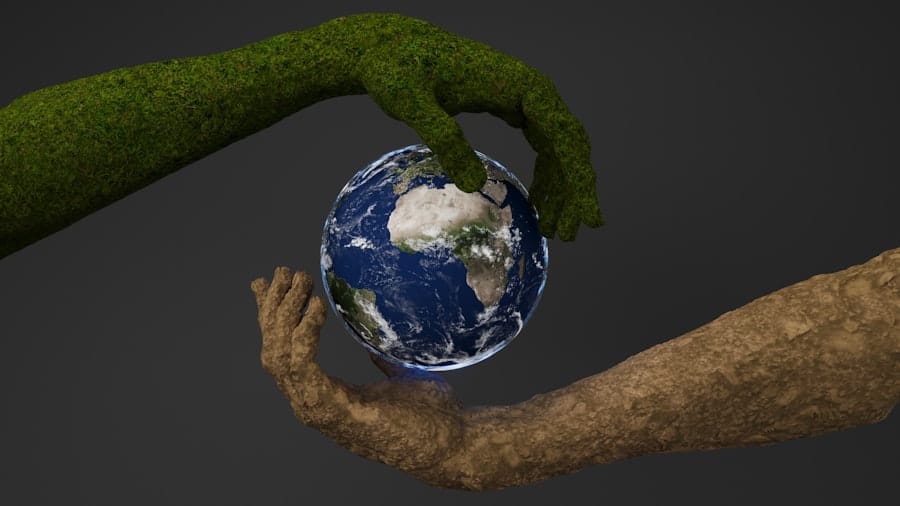The concept of a circular economy represents a paradigm shift from the traditional linear economic model, which follows a ‘take-make-dispose’ approach. In contrast, a circular economy emphasizes sustainability by promoting the continual use of resources, minimizing waste, and fostering an environment where products are designed for longevity, reuse, and recycling. This model seeks to create a closed-loop system where materials are kept in use for as long as possible, thereby reducing the strain on natural resources and mitigating environmental impacts.
The transition to a circular economy is not merely an environmental imperative; it also presents significant economic opportunities, as businesses can innovate and create new revenue streams while enhancing their resilience against resource scarcity. The urgency of adopting circular economy principles has been underscored by the growing awareness of climate change, resource depletion, and pollution. Governments, businesses, and consumers are increasingly recognizing the need for sustainable practices that can lead to a more balanced relationship with the planet.
For instance, the European Union has set ambitious targets to transition towards a circular economy by implementing policies that encourage recycling, waste reduction, and sustainable product design. This shift is not only about environmental stewardship; it also involves rethinking business models and consumer behavior to foster a culture of sustainability that permeates all levels of society.
Key Takeaways
- Circular economy aims to minimize waste and make the most of resources by reusing, sharing, and recycling materials.
- Tech innovations such as 3D printing, advanced recycling technologies, and renewable energy are driving the circular economy forward.
- Digital platforms play a crucial role in connecting businesses, consumers, and recyclers to facilitate the exchange and reuse of products and materials.
- Data analytics help businesses track and optimize their resource usage, waste generation, and recycling processes to improve their circular economy practices.
- Blockchain technology ensures transparency and traceability in the circular economy by securely recording transactions and product lifecycles.
Tech Innovations in Circular Economy
Technological innovations play a pivotal role in facilitating the transition to a circular economy. From advanced manufacturing techniques to smart materials, technology is enabling businesses to rethink how products are designed, produced, and disposed of. One notable example is the development of biodegradable materials that can replace conventional plastics.
Companies like Biome Bioplastics are pioneering the use of plant-based materials that decompose naturally, thus reducing plastic pollution and its associated environmental impacts. These innovations not only address waste management issues but also align with consumer demand for sustainable products. Moreover, additive manufacturing, commonly known as 3D printing, is revolutionizing production processes by allowing for on-demand manufacturing.
This technology minimizes waste by using only the necessary amount of material to create products, thus reducing excess inventory and the associated costs of storage and disposal. For instance, companies like Adidas have embraced 3D printing to produce customized footwear that meets individual consumer needs while minimizing material waste. Such innovations exemplify how technology can drive efficiency and sustainability in production processes, ultimately contributing to a more circular economy.
Digital Platforms for Circular Economy

Digital platforms are emerging as critical enablers of the circular economy by facilitating connections between consumers, businesses, and resources. These platforms provide marketplaces for second-hand goods, enabling consumers to buy and sell used items rather than purchasing new products. Websites like eBay and Poshmark exemplify this trend by creating vibrant ecosystems where pre-owned items can find new life, thereby extending their lifecycle and reducing waste.
Such platforms not only promote sustainable consumption but also empower consumers to make environmentally conscious choices. In addition to resale platforms, digital tools are being developed to enhance product lifecycle management. Companies like Circular IQ offer software solutions that help businesses track the materials used in their products and assess their environmental impact throughout the supply chain.
By providing insights into material flows and waste generation, these digital platforms enable companies to make informed decisions about product design and sourcing. This data-driven approach fosters transparency and accountability in supply chains, ultimately driving the adoption of circular practices across industries.
Data Analytics and Circular Economy
Data analytics is transforming how businesses approach sustainability within the framework of a circular economy.
For instance, companies like Unilever utilize data analytics to optimize their supply chains by identifying inefficiencies and areas for improvement.
This allows them to reduce waste and enhance resource efficiency while meeting consumer demand for sustainable products. Furthermore, predictive analytics can play a crucial role in extending product lifecycles. By analyzing usage patterns and maintenance data, companies can anticipate when products are likely to fail or require servicing.
This proactive approach enables businesses to offer repair services or replacement parts before products reach the end of their useful life. For example, companies like Philips have implemented predictive maintenance strategies for their medical equipment, ensuring that devices remain operational for longer periods while minimizing waste. Such applications of data analytics not only enhance operational efficiency but also contribute to a more sustainable approach to product management.
Blockchain and Circular Economy
Blockchain technology is increasingly recognized for its potential to enhance transparency and traceability within supply chains, which is essential for the successful implementation of circular economy principles. By providing an immutable ledger of transactions, blockchain enables stakeholders to track the movement of materials from production through to end-of-life disposal or recycling. This level of transparency fosters trust among consumers and businesses alike, as they can verify claims related to sustainability and ethical sourcing.
For instance, companies like Everledger are utilizing blockchain to create digital certificates for diamonds and other luxury goods, ensuring that they are sourced responsibly and ethically. This application not only helps combat issues like conflict diamonds but also promotes circular practices by encouraging recycling and reusing materials within the luxury market. Additionally, blockchain can facilitate the creation of decentralized marketplaces for recycled materials, allowing businesses to source high-quality inputs for new products while supporting local economies.
IoT and Circular Economy

The Internet of Things (IoT) is revolutionizing how products are monitored and managed throughout their lifecycle, providing valuable data that supports circular economy initiatives. By embedding sensors in products, manufacturers can gather real-time information about usage patterns, performance metrics, and maintenance needs. This data enables companies to optimize product design and improve durability while also facilitating proactive maintenance strategies.
For example, smart appliances equipped with IoT technology can alert users when maintenance is required or when parts need replacement. Companies like Whirlpool have integrated IoT capabilities into their washing machines, allowing users to monitor energy consumption and receive notifications about optimal washing cycles. This not only enhances user experience but also promotes energy efficiency and reduces wear-and-tear on appliances over time.
By leveraging IoT technology, businesses can create products that are more resilient and easier to maintain, ultimately contributing to a more sustainable circular economy.
AI and Circular Economy
Artificial intelligence (AI) is playing an increasingly significant role in driving innovation within the circular economy by enabling smarter decision-making processes across various sectors. AI algorithms can analyze vast datasets to identify patterns and trends that inform product design, resource allocation, and waste management strategies. For instance, companies like Google are using AI to optimize energy consumption in their data centers by predicting usage patterns and adjusting cooling systems accordingly.
This not only reduces energy waste but also enhances overall operational efficiency. Moreover, AI can facilitate more effective recycling processes by improving sorting technologies. Advanced machine learning algorithms can be trained to recognize different types of materials in recycling facilities, enabling more accurate sorting of recyclables from waste streams.
By enhancing recycling efficiency through AI technologies, businesses can significantly increase the recovery rates of valuable materials while reducing contamination in recycling streams.
Future Trends in Tech-Enabled Circular Economy Solutions
As we look toward the future, several trends are emerging that will shape tech-enabled solutions within the circular economy landscape. One notable trend is the increasing integration of artificial intelligence with other technologies such as IoT and blockchain to create comprehensive systems that enhance sustainability efforts across industries. For example, combining AI-driven analytics with IoT data from connected devices can provide businesses with real-time insights into resource usage patterns while ensuring transparency through blockchain verification.
Another trend is the rise of collaborative consumption models facilitated by digital platforms that promote sharing rather than ownership. Companies like Zipcar have pioneered car-sharing services that allow users to access vehicles on-demand without the need for ownership. This model not only reduces the number of cars on the road but also encourages more efficient use of resources by maximizing vehicle utilization rates.
Additionally, there is a growing emphasis on regenerative practices within the circular economy framework. Businesses are increasingly recognizing the importance of not just minimizing waste but actively restoring ecosystems through their operations. Companies like Interface have committed to achieving carbon neutrality by implementing regenerative practices in their manufacturing processes while promoting sustainable sourcing of raw materials.
In conclusion, as technology continues to evolve and reshape our understanding of sustainability within the context of a circular economy, it is clear that innovative solutions will play a crucial role in driving this transformation forward. The convergence of various technologies will enable businesses to adopt more sustainable practices while creating new opportunities for growth in an increasingly resource-constrained world.
In the rapidly evolving landscape of sustainable technology, the article “How Tech Is Enabling Circular Economy Solutions” highlights the pivotal role of innovative tools in promoting eco-friendly practices. A related piece that complements this discussion is the review of NeuronWriter, a cutting-edge content SEO optimization tool. This tool not only enhances digital content efficiency but also aligns with the principles of a circular economy by optimizing resource use and minimizing waste in digital marketing strategies. For more insights, you can read the full review in the article here.
FAQs
What is the circular economy?
The circular economy is an economic system aimed at eliminating waste and the continual use of resources. It focuses on reusing, sharing, repairing, refurbishing, and recycling existing materials and products to create a closed-loop system, minimizing the use of raw materials and reducing waste.
How is technology enabling circular economy solutions?
Technology is enabling circular economy solutions by providing innovative tools and platforms for resource tracking, material recovery, product lifecycle management, and waste reduction. This includes the use of IoT devices, blockchain, AI, and data analytics to optimize resource usage and create more sustainable production and consumption patterns.
What are some examples of tech-enabled circular economy solutions?
Examples of tech-enabled circular economy solutions include digital platforms for sharing and reusing products, IoT sensors for tracking and optimizing resource usage, AI-powered predictive maintenance for extending product lifecycles, and blockchain for transparent and traceable supply chains.
How does tech contribute to the reduction of e-waste in the circular economy?
Technology contributes to the reduction of e-waste in the circular economy by enabling the refurbishment, remanufacturing, and recycling of electronic products. This includes the development of specialized recycling technologies, as well as the implementation of reverse logistics and take-back programs facilitated by digital platforms and data analytics.
What are the potential benefits of tech-enabled circular economy solutions?
The potential benefits of tech-enabled circular economy solutions include reduced resource consumption, minimized waste generation, lower environmental impact, increased resource efficiency, and the creation of new business opportunities and revenue streams through the development of sustainable products and services.

